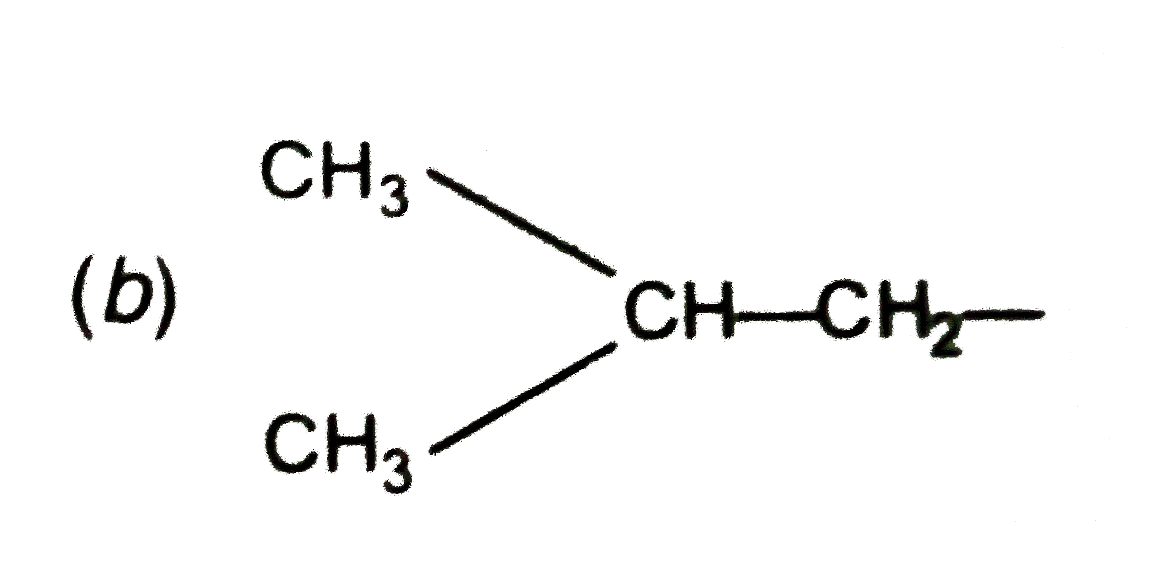The structure of isobutyl group in an organic compound is
(1) CH3−CH∣−CH2−CH3
(2) CH3−CH2−CH2−CH2−
(3) CH3−CH3∣C∣CH3−
(4) 
To determine the structure of the isobutyl group in an organic compound, we can follow these steps:
Step 1: Understand the Isobutyl Group
The isobutyl group is a branched alkyl group derived from butane. It is specifically known as 2-methylpropyl.
Step 2: Identify the Carbon Backbone
The isobutyl group consists of a total of four carbon atoms. The structure can be visualized as a three-carbon chain (propyl) with a methyl group (–CH₃) attached to the second carbon.
Step 3: Draw the Structure
1. Start with the three-carbon chain (propyl):
- C1 - C2 - C3
2. Attach a methyl group (–CH₃) to the second carbon (C2):
- C1 - C2 (with a methyl group) - C3
3. The hydrogen atoms will be added to satisfy the tetravalency of carbon.
Step 4: Final Structure
The final structure of the isobutyl group can be represented as:
CH3|CH3−C−CH2|H
This structure shows that the isobutyl group has one carbon (C1) bonded to three hydrogens and a carbon (C2) bonded to one methyl group and one hydrogen, while the third carbon (C3) is bonded to two hydrogens.
Summary of the Isobutyl Group Structure
- The isobutyl group has the formula: C₄H₉
- It is represented as: (CH₃)₂CH–
The isobutyl group is a branched alkyl group derived from butane. It is specifically known as 2-methylpropyl.
The isobutyl group consists of a total of four carbon atoms. The structure can be visualized as a three-carbon chain (propyl) with a methyl group (–CH₃) attached to the second carbon.
1. Start with the three-carbon chain (propyl):
- C1 - C2 - C3
2. Attach a methyl group (–CH₃) to the second carbon (C2):
- C1 - C2 (with a methyl group) - C3
3. The hydrogen atoms will be added to satisfy the tetravalency of carbon.
The final structure of the isobutyl group can be represented as:
CH3|CH3−C−CH2|H
This structure shows that the isobutyl group has one carbon (C1) bonded to three hydrogens and a carbon (C2) bonded to one methyl group and one hydrogen, while the third carbon (C3) is bonded to two hydrogens.
- The isobutyl group has the formula: C₄H₉
- It is represented as: (CH₃)₂CH–
Topper's Solved these Questions
- BOOK - R SHARMACHAPTER - NOMENCLATURE OF ORGANIC COMPOUNDSEXERCISE - Question Bank31videos
NOMENCLATURE OF ORGANIC COMPOUNDS
- BOOK - R SHARMACHAPTER - ISOMERISMEXERCISE - Archives11videos
ISOMERISM
- BOOK - R SHARMACHAPTER - PURIFICATION AND CHARATERIZATION OF ORGANIC COMPOUNDSEXERCISE - Archives38videos
PURIFICATION AND CHARATERIZATION OF ORGANIC COMPOUNDS
Similar Questions
Knowledge Check
- Question 1 - Select One
The structure of isoburtyl group in an organic compound is :
A CH3 |CH3−C− |B CCH3−CH3∣CH−CH2−CH3DCH3−CH2−CH2−CH2−
CCH3−CH3∣CH−CH2−CH3DCH3−CH2−CH2−CH2− - Question 2 - Select One
Carbylamine test is used to detect the presence of primary amino group in an organic compound. Which of the following compound is formed when this test is performed with aniline?
A B
B C
C D
D
- Question 3 - Select One
CH3COCl is used to detect the number of amino groups in the organic compounds. When a compound of molecular mass 180 is acetylated, gives a compound of molecular mass 390. The number of amino groups in the compound is
A1B2C5D4
What is meant by functional group in an organic compound ? Give the structural formular of the functional groups in (i) Acetic acid (ii) Ethyl alcohol.
View SolutionName the functional group present in an organic compound which gives brisk effervescence with NaHCO3
View SolutionWhich one of the following tests used for the identification of functional groups in organic compounds does not use copper reagent?
View SolutionThe IUPAC name for isobutyl group is
View SolutionA bond which is formed between aldehyde or ketone group of monosaccheride and alcoholic group of another organic compound is known as
View Solution

